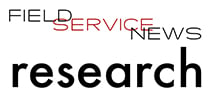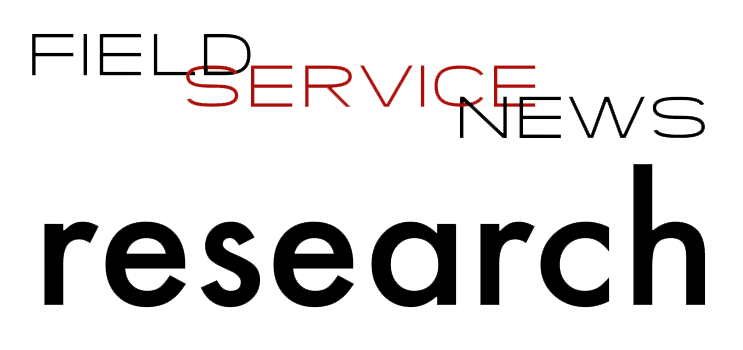The Ongoing Impact of the Pandemic on Field Service Operations...
In a new series of features from the latest Field Service News Research study hosted in partnership with ServiceMax, we explore the correlations between asset data flow, servitization and cross-department collaboration. Here in the first feature reviewing this data we explore the ongoing disruption caused by the pandemic on the field service sector...
To open the study, we asked our respondents to define the most significant change for them within the last eighteen months. Overwhelmingly, the provision of remote services to be added to a portfolio was the most widely cited of any response. (fig. 1 below)
Almost two-thirds of respondents (64%) stated that this was the case for them. As we touched on in the introduction, while the adoption of remote service delivery is aligned mainly to the implementation of technology, it naturally leads to a significant shift in service design thinking.
The skill sets required of the technicians and engineers within the field service workforce will be significantly different in many ways.
This shift was also reflected in the responses to this question, with workforce-related answers equating to over a fifth of the responses. These included ‘more flexible shift patterns within the field service division’, ‘increased usage of third party works’ and ‘a change in the profile of field service technicians/engineers’ all cited.
The adoption of remote service has also not just been a push by the service providers. Two-thirds (67%) of field service companies within the study stated that they felt a more significant customer push to introduce remote service into their service portfolio.
In comparison, 20% of respondents had seen a similar increase in customer demand for self-service solutions. However, one abundantly clear finding is that a lingering impact of the pandemic is that customers’ expectations in terms of service standards have continued to increase despite the more challenging environments we find ourselves in.
80% of respondents stated they felt their customers expect more today in service standards than they did eighteen months ago.

As we break this down, the good news is that many of the leading issues that customers want to see resolved are critical areas of focus already within the industry, with solutions readily available.
We asked our respondents what are the most significant ways in which customer expectations are changing? We provided them with a selection of responses and asked them to tick any relevant options.
The most widely cited responses were faster response times (67%), increased remote service options (58%) and a better understanding of asset performance and asset condition (42%). (fig 2 below)
Interestingly, these three responses being the most commonly referenced are also three essential components within a servitized model where the shift from a focus on strict SLA adherence to one of guarantees of uptime would occur.
Indeed, only 17% of respondents cited more stringent SLA commitments within the response group.
Meanwhile, slightly under a third (31%) of respondents stated their customers were looking for greater proof of the value delivered. At the same time, just over a quarter (28%) also indicated that their customers now expected a wider portfolio of services.
We next asked our respondents to define in their own words the primary way their organisations were adapting to meet these needs.
There were several trends that emerged in this section. Still, the most repeated comments were aligned to increases in and development of staff, the adoption of remote service delivery, and a drive towards connected assets.
Furthermore, when we drilled down further into this area and asked our respondents to identify the most positive initiatives introduced within the last eighteen months in terms of revenue generation and customer satisfaction, the introduction of remote service tools again dominated the responses.

 If you are a Field Service News subscriber on either our free-forever FSN Standard subscription tier or our Premium Subscription tier you can access the full 18-page report written by Field Service News, Editor-in-Chief, Kris Oldland that offers in-depth analysis of the research project now on the button below.
If you are a Field Service News subscriber on either our free-forever FSN Standard subscription tier or our Premium Subscription tier you can access the full 18-page report written by Field Service News, Editor-in-Chief, Kris Oldland that offers in-depth analysis of the research project now on the button below.
If you are not yet a subscriber to Field Service News but would like to subscribe and gain access to this report instantly, click the button to visit a dedicated registration page for our complimentary sponsored subscription tier and that will give you instant access to this paper and a number of other assets currently available to subscribers on this tier.
 Data usage note: By accessing this content you consent to the contact details submitted when you registered as a subscriber to fieldservicenews.com to be shared with the listed sponsor of this premium content, ServiceMax who may contact you for legitimate business reasons to discuss the content of this study.
Data usage note: By accessing this content you consent to the contact details submitted when you registered as a subscriber to fieldservicenews.com to be shared with the listed sponsor of this premium content, ServiceMax who may contact you for legitimate business reasons to discuss the content of this study.
Written by Kris Oldland
Kris Oldland has been working in Business to Business Publishing for almost a decade. As a journalist he has covered a diverse range of industries from Fire Juggling through to Terrorism Insurance. Prior to this he was a Quality Services Manager with a globally recognised hospitality brand. An intimate understanding of what is important when it comes to Service and a passion for emerging technology means that in Field Service he has found an industry that excites him everyday.


